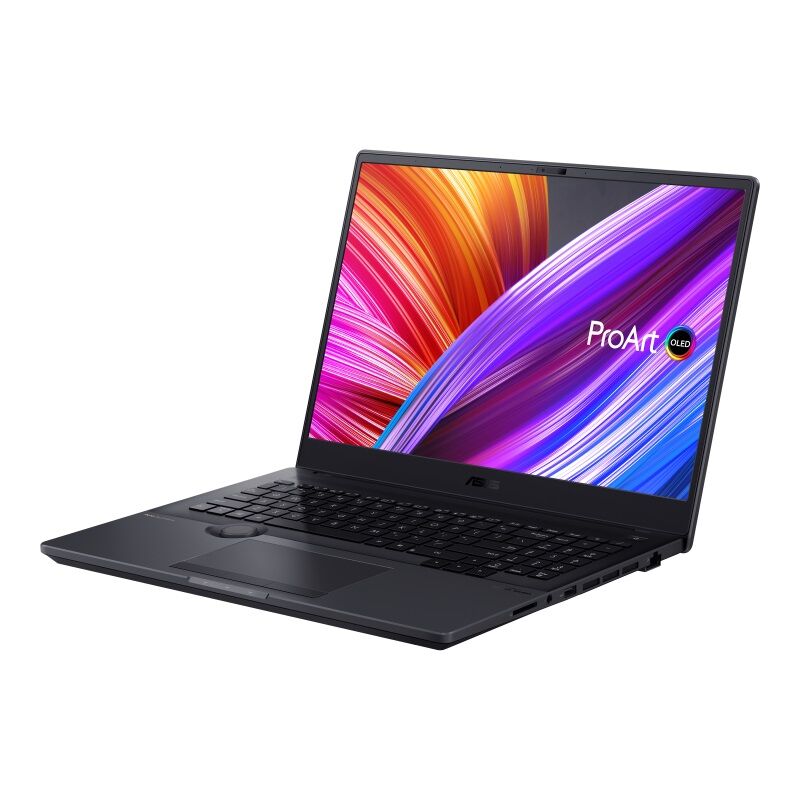

Asus’ new MacBook Pro rival costs $5,000
source link: https://arstechnica.com/gadgets/2021/12/asus-proart-studiobook-pro-16-oled-is-a-5000-macbook-pro-alternative/
Go to the source link to view the article. You can view the picture content, updated content and better typesetting reading experience. If the link is broken, please click the button below to view the snapshot at that time.

Pricey power —
Asus’ new MacBook Pro rival costs $5,000
Includes Intel Xeon W-11955M, Nvidia RTX A5000 graphics, and a tall OLED screen.
Scharon Harding - 12/6/2021, 6:18 PM

On Monday, Asus released a number of clamshells, including new business-focused ExpertBook B5s, which start at $1,300. Four new ProArt Studiobooks begin at $2,000. But if you want to splurge, look to the Asus ProArt Studiobook Pro 16 OLED (W7600), which comes with an Intel Xeon processor and Nvidia RTX graphics and costs a whopping $5,000.
All four of the ProArt Studiobook Pro OLEDs announced today (the W7600, H7600, H5600, and W5600) come with the Pro version of Windows and a 16-inch OLED screen with HDR support and slightly greater than 4K resolution (3840×2400 versus 3840×2160), thanks to a 16:10 aspect ratio.
For comparison, the 16-inch MacBook Pro has a 16.2-inch screen with a 3456×2234 resolution. It can also go up to 120 Hz, based on what you're doing. The Apple laptop's screen has a lower pixel density (254 pixels per inch) than the Asus (283 ppi) and uses Mini LED technology, which is generally a step down contrast-wise from OLEDs. On the upside, the MacBook Pro has a brighter screen (up to 1,000 nits full-screen, compared to the Studiobook's claimed 550 nits).
All of the Asus Studiobooks announced today come with up to 64GB of DDR4-3200 memory and a pair of PCIe slots (one version 4.0 x4, the other 3.0 x4). That means you can get up to 4TB of storage in these powerhouses. These max specs will cost you $5,000; a similar configuration on the 16-inch MacBook Pro comes in at a comparable $4,900. You can increase the storage to 8TB on the MacBook Pro, but that bumps the price by $1,200.
The Studiobook has a decent selection of ports: one Thunderbolt 4, one USB-C (3.2 Gen 2), a pair of USB-A ports (3.2 Gen 2), the latest HDMI (2.1), RJ45 Ethernet, and a 3.5 mm jack. Apple's 16-inch MacBook Pro has three Thunderbolt ports but no USB-A or Ethernet. The MacBook Pro has an HDMI port, but it uses HDMI 2.0, not 2.1.
Advertisement
The ProArt Studiobook Pro 16 OLED (W7600) differentiates itself—and its price tag—from the other Studiobooks with its CPU and GPU. While the other ProArt Studiobooks include up to an Intel Core i7-11800H and an Nvidia GeForce RTX 3060, the W7600 can handle an Intel Xeon W-11955M and an RTX A5000.
Intel's Xeon lineup is reserved for more powerful workstations and servers. The Xeon W-11955M was announced in May for mobile workstations. It has eight CPU cores, 16 threads, and a 2.6 GHz clock speed that can boost to 5 GHz. The laptop's product page says you can boost TDP from 45 W to 95 W temporarily or use a sustained 75 W via "performance" mode. (The most expensive version of Apple's 16-inch MacBook Pro uses the M1 Max. These are different breeds of cores, but the chip has 10 CPU cores and 32 GPU cores. For an in-depth look at the M1 Max, check out our 2021 Macbook Pro review.)
Meanwhile, Nvidia announced the RTX A5000 in April for professionals seeking thin-and-light laptops. The mobile GPU has 16GB of GDDR6 memory and can boost up to 1455 MHz at 110 W. Asus used it in the W7600 to cater to those handling workloads with tasks like CAD modeling, high-res video editing, and 3D product designing. Asus opted for the slimmer Max-Q version of the RTX A5000.
Asus' new laptop is 0.77 inches (19.6 mm) thick and weighs approximately 5.29 lbs (2.4 kg), according to Asus' announcement. The 16-inch MacBook Pro is thinner (0.66 inches /16.76 mm) and lighter (4.8 lbs / 2.2 kg with an M1 Max).
Asus says the ProArt Studiobook Pro 16 OLED can support a TDP of up to 140 W. The company didn't mention high-load noise levels, but in "normal" (rather than "performance") mode, the company promises that the sound of those fans whizzing will be under 40 dBA.
All of the new ProArt Studiobooks are available now, except for the ProArt Studiobook Pro 16 OLED (W5600), which arrives in the first quarter of 2022.
Ars Technica may earn compensation for sales from links on this post through affiliate programs.
Recommend
About Joyk
Aggregate valuable and interesting links.
Joyk means Joy of geeK